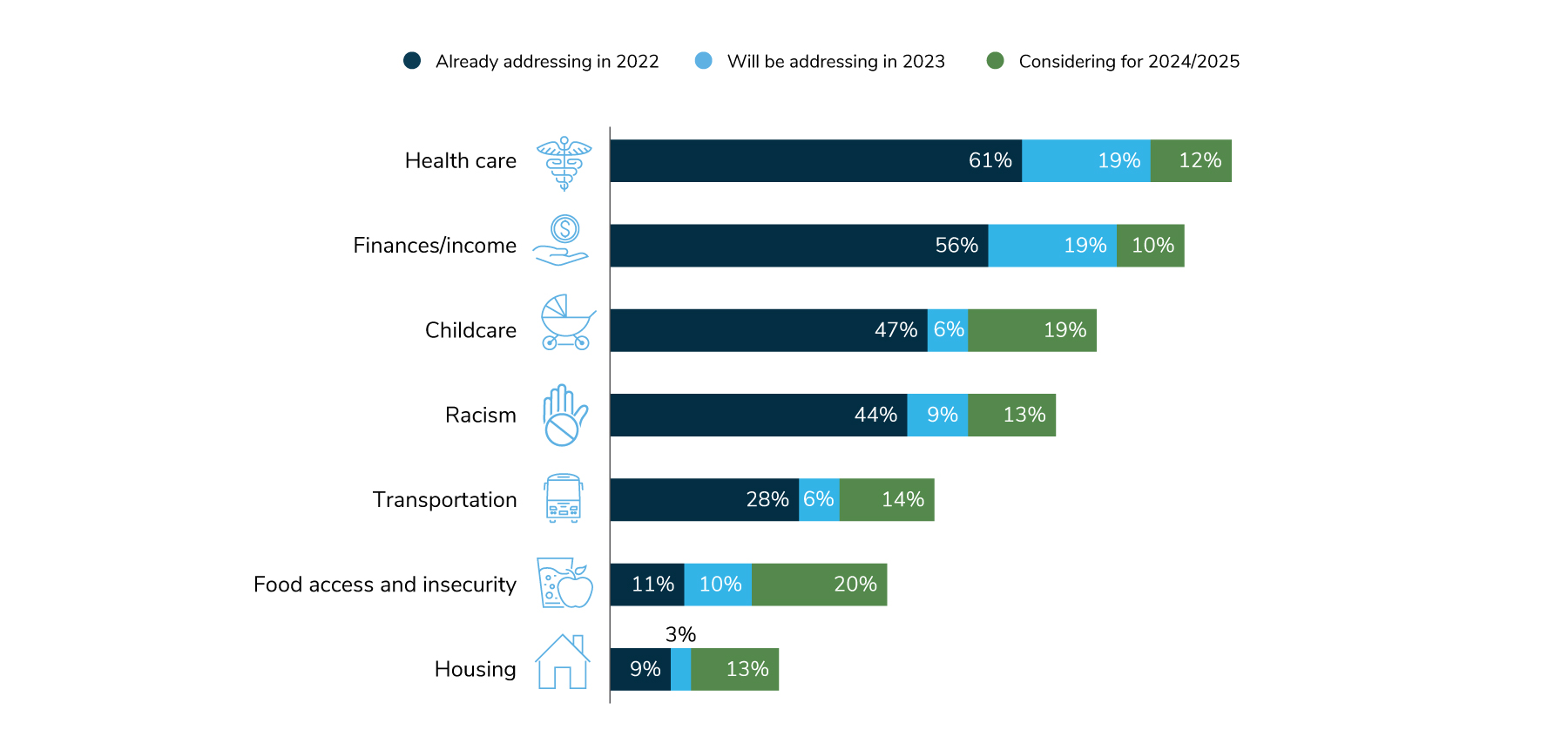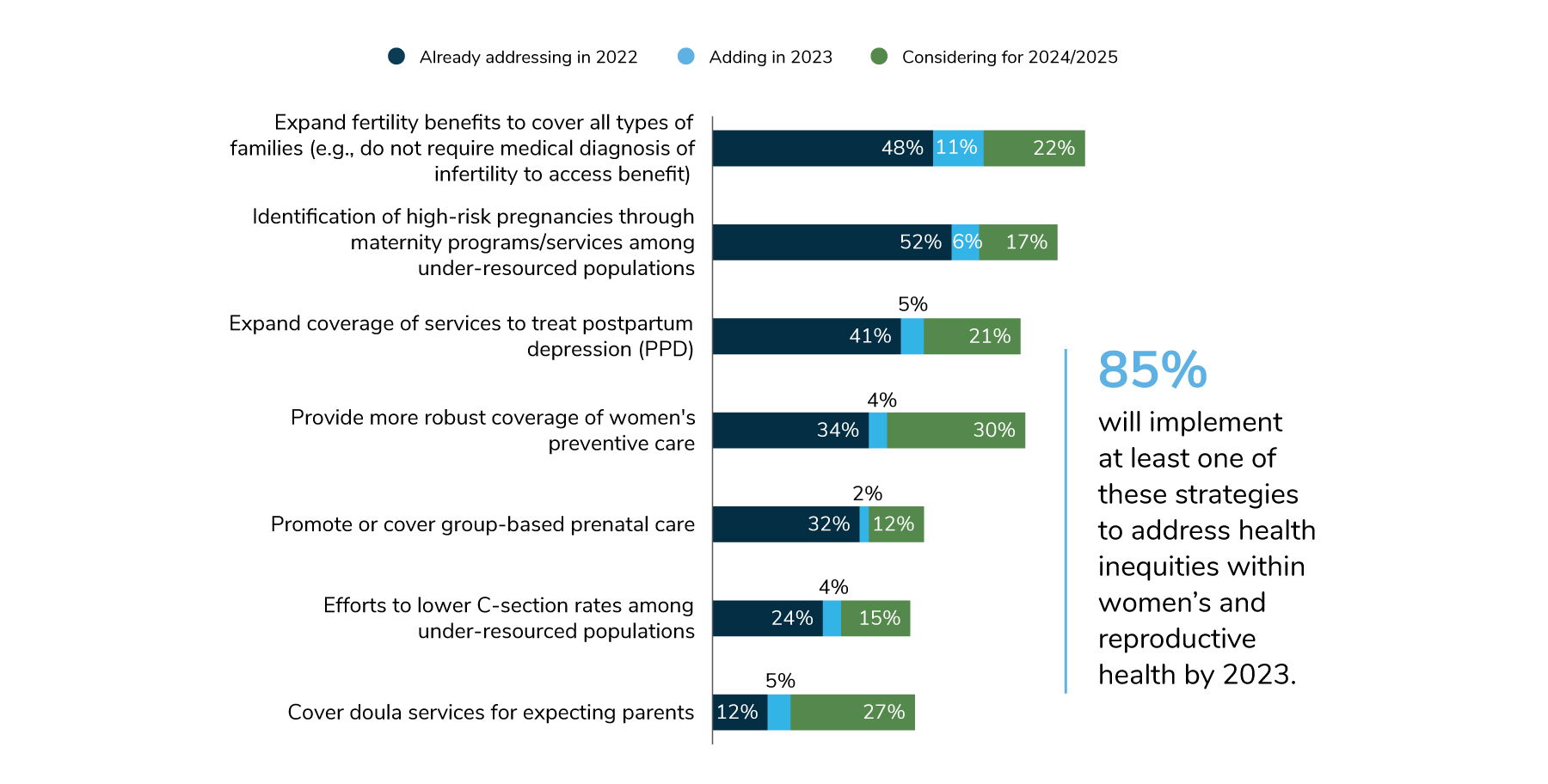August 23, 2022
Looking for the latest data?
Check out our 2024 Large Employer Health Care Strategy Survey, released in August 2023.
Key Takeaways
- Seventy-five percent of large employers are concerned about health equity within their health and well-being initiatives.
- Health care access and finances/income are the top two social determinants of health (SDOH) addressed by employers, while childcare and food access/insecurity will receive increased focus over the next 2 years.
- In 2023, employers will address health inequities in a multitude of ways, including by offering or expanding coverage of transgender health care benefits (82%); expanding benefits to support a neurodiverse population (78%); and ensuring that family-forming benefits are available to all types of families (59%).
2021 saw significant strides related to health equity, as many employers stepped up their efforts to foster equity within their health plans and well-being initiatives, whether directly or through their vendor partners. As expected, in 2022, large employers continue to show concern about health equity in their company’s health and well-being initiatives – in fact, three in four employers feel this way. These concerns are being addressed through various strategies.
Social Determinants of Health (SDOH) Continue to Grow in Focus
Employers are continuing to explore programs and benefits to address the circumstances that employees and their families are born into and live, which have an impact on employees’ ability to live healthy and fulfilling lives. Through partnerships with community organizations, vendors and internal campaigns launched by employee resource groups (ERGs), employers can actively address the underlying social and economic challenges that influence regular health habits, overall well-being and even one’s mortality.
However, some SDOH receive greater attention from employers than others, typically those that closely align with well-being programs and have easier-to-implement solutions (Figure 2.1)

Health Care
Health care is the top way employers are addressing SDOH, with 61% of employers already focusing on it in 2022 and another 31% planning to do so before 2025. Employers have a renewed drive to offer affordable premiums and ensure that out-of-pocket costs are manageable for all employees. In addition, there has been a concerted effort, on many fronts, to ensure that employees can find a provider that is convenient, accepting new patients, has appointment availability and aligns with the qualities an employee is seeking in a provider (Figure 2.2)
Finances/Income
Finances/income is another SDOH that can be supported through employers’ well-being initiatives. With 56% currently pursuing this SDOH, that number could climb to 85% in just 3 years. Figure 2.2 illustrates some examples of how employers are supporting lower-wage employees.

Childcare
Childcare, specifically providing access to affordable childcare, can have a profound impact on an employee’s family. Not only is their child able to get a jump-start in their development and education, but affordable, reliable childcare also gives employees peace of mind while they’re at work, enabling them to stay focused and productive. Currently, 47% of employers are addressing childcare; this is another SDOH that is anticipated to see growth in the next few years.
Other SDOH, including racism, transportation, food access/insecurity and housing, are on the rise.
This year, employers’ efforts pertaining to women’s reproductive services, transgender benefits and access to affordable care were magnified. In particular, the overturn of Roe v. Wade, which eliminated federal protection for abortion, has increased some employers’ focus on women’s health.
Achieving Health Equity in Women's and Reproductive Health
As more data and anecdotes come to light on maternal health disparities, employers readily recognize that this is an area that needs attention. As a result, there will be a substantial level of movement in fertility benefits as employers continue to expand their offerings to ensure access among their workforces. For example, some employers are removing the requirement that an employee needs to be diagnosed with infertility before receiving access to benefits. Upwards of 81% will make fertility benefit access a priority in the coming years (Figure 2.3).
Employers are also exploring how to fill gaps in obstetric care, either from a quality or access standpoint. Identifying high-risk pregnancies among under-resourced populations is currently practiced by 52% of employers but is expected to jump to 75% in 2024-2025. Along the same lines, 24% have made efforts to lower C-section rates among under-resourced populations. In addition, expansion of coverage for specific services is also on the rise: 1) services to treat postpartum depression (41% to 67%); 2) group-based prenatal care (32% to 46%); and 3) doula services (12% to 44%) (Figure 2.3.). These supports will no doubt help those looking to expand their families, although promotion and integration of these options will be necessary to fully realize equity goals set by employers.

Employers are also prioritizing two other key areas of women’s health: preventive care and abortion access. One-third of employers are enhancing their preventive care coverage for women; that number could multiply to 68% in a few years. Additionally, 44% have either expanded or plan to expand access to abortion services (in light of the Roe v. Wade reversal), with most turning to travel and accommodation support for employees seeking abortion services.
Neurodiversity
In the area of neurodiversity, employers have historically focused on supporting employees and dependents with autism spectrum disorder. In recent years, some employers are expanding their neurodiversity benefits to aid those with other conditions that may affect occupational skillsets and personal interactions. These include attention deficit hyperactivity disorder (ADHD), dyslexia and social anxiety disorders. Seventy-six percent of employers are following this practice, with an additional 11% planning to do so in in the coming years (Figure 2.2).
Transgender Benefits
Another area of focus is expanding the breadth of transgender benefits covered by the health plan or increasing the maximum amount reimbursed. Most employers cover transgender benefits (74%), and a few more employers (13%) are expected to join in before 2025. Surgical procedures and reproductive benefits are common areas of expansion.
Affordability of Care
Another area related to health equity that employers are paying attention to is affordability. Employers have long focused on affordability and are increasingly doing so in the coming years. In line with findings observed later in the report, employers (73%) are continuing to offer a choice of health plans to employees (Figure 2.2), enabling employees to select the right plan for them. In addition, some employers (61% in 2022) are designing benefits to foster affordability within pharmacy benefits. While not as common, eventually half of employers expect to have wage-based cost sharing built into their plans.
Access to Providers
Finally, employers know that a pain point of the health care experience is being able to find the right provider. This is most acute when it comes to finding physical and mental health practitioners but also extends to the use of health plan resources, navigational services and well-being programs. To give employees the best chance of finding a provider with a specific expertise (e.g., gender transition) or demographic background (race/ethnicity), employers are working with their vendors to expand their provider networks (Figure 2.2). This is the fastest-growing area of health equity.
To achieve this goal, the first step is to collect and publish provider information that helps employees find providers that best meet their needs and preferences. In fact, 44% of employers require their health plan and navigation partners to maintain provider directories, but this number is expected to grow to 80% by 2025. Taking it a step further, 37% of employers will actively expand their provider networks to represent a more diverse group of professionals – and this number will double in just 3 years. Finally, while it’s important that all providers practice culturally competent care, giving employees more choice and control over whom they seek services from can lead to better adherence, satisfaction and outcomes.

Part 2: Health Equity
-
Introduction2023 Large Employers’ Health Care Strategy and Plan Design Survey
-
Full Report2023 Large Employers’ Health Care Strategy Survey: Full Report
-
Executive Summary2023 Large Employers’ Health Care Strategy Survey: Executive Summary
-
Chart Pack2023 Large Employers’ Health Care Strategy Survey: Chart Pack
-
InfographicInfographic: Managing Rising Health Care Costs in 2023
-
Part 12023 Large Employers’ Health Care Strategy Survey: Perspectives on the Evolving Health Care Landscape
-
Part 22023 Large Employers’ Health Care Strategy Survey: Health Equity
-
Part 32023 Large Employers’ Health Care Strategy Survey: The Health Care Delivery System
-
Part 42023 Large Employers’ Health Care Strategy Survey: Health and Pharmacy Plan Design
-
Part 52023 Large Employers’ Health Care Strategy Survey: Health Care Costs and 2023 Priorities
-
InfographicInfographic: Prescription Costs and Pharmacy Benefits
-
InfographicInfographic: Cancer - Improve Quality, Reduce Costs
More Topics
Articles & Guides
This content is for members only. Already a member?
Login
![]()
